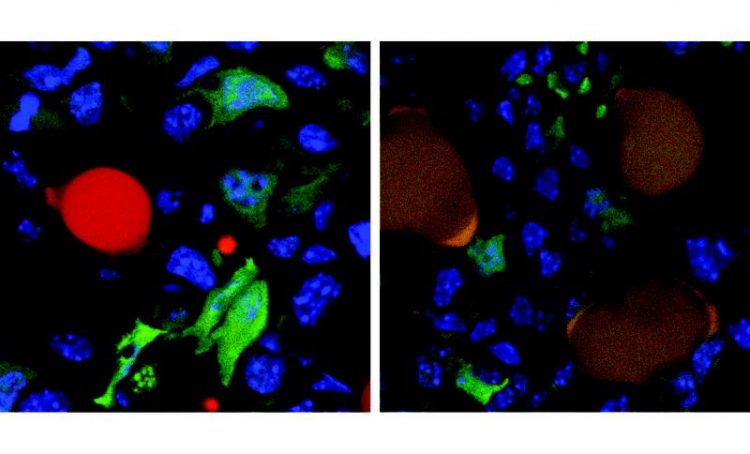Conversion of breast cancer cells into fat cells impedes the formation of metastases

Cancer cells marked in green and a fat cell marked in red on the surface of a tumor (left). After treatment (right), three former cancer cells have been converted into fat cells (dark yellow). Image: University of Basel, Department of Biomedicine
Tumor cells can adapt dynamically to changing conditions thanks to their ability to reactivate a cellular process that is central to embryonic development. This allows the cells to alter their molecular properties and to acquire new capabilities.
As a result, resident cells can adopt the properties of other cell types and break away from their cell cluster. Once mobile, the cells migrate via the bloodstream to other regions of the body, where they undergo a further conversion before taking root and forming new tissue structures.
Adaptable cancer cells
In the embryo, this epithelial–mesenchymal transition (EMT) is instrumental to the development of organs. Tumor cells, however, exploit the process in order to leave the primary tumor so that they can spread around the body and form metastases in distant organs.
The research group led by Professor Gerhard Christofori at the University of Basel’s Department of Biomedicine researches the molecular processes that regulate the cellular EMT program.
Its aim is to demonstrate new approaches to combating the development of tumors and the formation of metastases – such as in the case of breast cancer, one of the most common and malignant diseases in women.
Exploiting adaptability
Malignant cancer cells exhibit a high degree of adaptability – referred to as plasticity – as they undergo the cellular EMT program. Now, the researchers have exploited this property in order to develop a new type of therapeutic approach.
In experiments on mice, they have succeeded in using a combination of two active substances to convert breast cancer cells, which divide quickly and form metastases, into fat cells that can no longer divide and can barely be differentiated from normal fat cells. This stops the tumor from invading the neighboring tissue and blood vessels, and no further metastases can form.
This novel differentiation therapy is based on a combination of two drugs: Rosiglitazone, which is widely used to treat patients with diabetes, and Trametinib, which inhibits the growth and spread of cancer cells.
“In future, this innovative therapeutic approach could be used in combination with conventional chemotherapy to suppress both primary tumor growth and the formation of deadly metastases,” says Professor Gerhard Christofori. Furthermore, the research findings show that malignant cancer cells – like stem cells – exhibit a high degree of cell plasticity, which can be exploited for therapeutic purposes.
Prof. Dr. Gerhard Christofori, University of Basel, Department of Biomedicine, Tel. +41 61 207 35 62, email: gerhard.christofori@unibas.ch
Dana Ishay Ronen, Maren Diepenbruck, Ravi Kiran Reddy Kalathur, Nami Sugiyama, Stefanie Tiede, Robert Ivanek, Glenn Bantug, Marco Francesco Morini, Junrong Wang, Christoph Hess, and Gerhard Christofori
Gain Fat—Lose Metastasis: Converting Invasive Breast Cancer Cells into Adipocytes Inhibits Cancer Metastasis
Cancer Cell (2019), doi: 10.1016/j.ccell.2018.12.002
https://biomedizin.unibas.ch/en/research/research-groups/christofori-lab/ Research group of Prof. Gerhard Christofori
Media Contact
More Information:
http://www.unibas.chAll latest news from the category: Life Sciences and Chemistry
Articles and reports from the Life Sciences and chemistry area deal with applied and basic research into modern biology, chemistry and human medicine.
Valuable information can be found on a range of life sciences fields including bacteriology, biochemistry, bionics, bioinformatics, biophysics, biotechnology, genetics, geobotany, human biology, marine biology, microbiology, molecular biology, cellular biology, zoology, bioinorganic chemistry, microchemistry and environmental chemistry.
Newest articles

A ‘language’ for ML models to predict nanopore properties
A large number of 2D materials like graphene can have nanopores – small holes formed by missing atoms through which foreign substances can pass. The properties of these nanopores dictate many…

Clinically validated, wearable ultrasound patch
… for continuous blood pressure monitoring. A team of researchers at the University of California San Diego has developed a new and improved wearable ultrasound patch for continuous and noninvasive…

A new puzzle piece for string theory research
Dr. Ksenia Fedosova from the Cluster of Excellence Mathematics Münster, along with an international research team, has proven a conjecture in string theory that physicists had proposed regarding certain equations….



